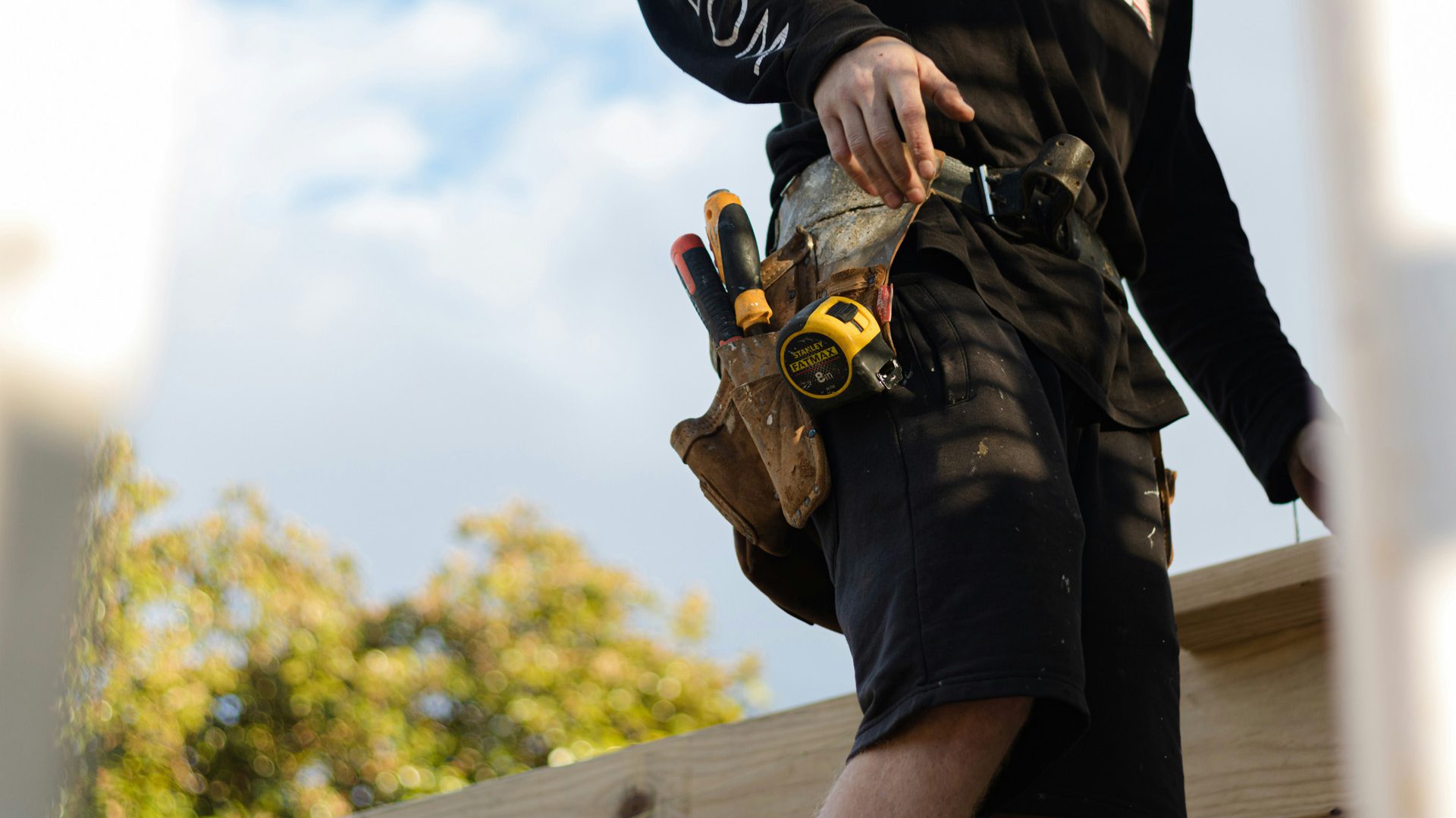The big self-build conundrum – DIY vs Professional
Based on extensive research across UK construction industry sources, building regulations, insurance providers, and real-world case studies, this article provides comprehensive guidance for self-builders making DIY vs professional decisions. The findings reveal that while DIY can deliver 40-50% cost savings, success requires careful trade selection, regulatory compliance, and realistic assessment of skills and time commitments.

Trade-by-trade assessment reveals quite clear DIY boundaries
The feasibility of DIY work varies dramatically across construction trades, with some offering excellent opportunities for cost savings while others require mandatory professional involvement. Our analysis of 14 key trades shows distinct patterns in skill requirements, regulatory constraints, and financial implications.
High DIY potential trades offer 40-60% savings
Plastering emerges as the most financially rewarding DIY trade, with potential labour savings of 50-60% (£300-800 per room). Despite requiring intermediate to advanced skills, the absence of legal certification requirements and manageable safety risks make it attractive for committed DIYers. Professional plasterers charge £550-1,350 per room, while materials cost only £150-300.
Decorating provides the easiest entry point for beginners, with 60-80% labour savings possible. Professional painters charge £150-400 daily, but DIY decorators need only £90-315 in tools. The work involves minimal regulatory oversight and offers forgiving learning curves where mistakes can be easily corrected.
Basic carpentry and flooring represent solid middle-ground options. Laminate flooring installation saves 50-70% on professional costs of £15-40/m², while carpentry work offers flexibility from simple shelving to complex joinery. Both trades benefit from widely available training courses (£250-475) and pose moderate safety risks.
Legally restricted trades demand professional expertise
Gas work stands absolutely prohibited for DIY under Gas Safety Regulations 1998. All gas installations, servicing, and repairs must be completed by Gas Safe registered engineers. Attempting DIY gas work constitutes a criminal offense and automatically invalidates home insurance.
Electrical work faces severe restrictions through Part P Building Regulations. While minor additions to existing circuits remain technically permissible, all work must comply with BS 7671:2018 standards and receive proper certification. New circuits, consumer unit work, and installations in bathrooms require notification and inspection. Non-compliance risks unlimited fines and up to two years imprisonment under the Building Safety Act 2022.
Structural work necessitates professional calculations from qualified engineers. Load-bearing alterations, new openings, and foundation designs require Building Control approval with supporting calculations. DIY structural drawings are not acceptable, and professional indemnity insurance is mandatory for engineers providing calculations.
Complex trades present poor DIY economics
Timber frame erection offers minimal savings (10-15%) while demanding advanced skills and expensive equipment hire (£2,000-4,000). Professional teams complete frames in 5-7 days versus 3-6 weeks for DIY attempts, with warranty implications often requiring certified erectors.
External rendering technically allows 40-50% savings but carries high failure risks. Professional costs of £30-80/m² include expertise in weather-dependent application, structural knowledge, and expensive scaffolding. Most warranty providers recommend professional installation for this critical weatherproofing element.
Roofing work above replacement tiles requires professional skills despite 30-40% potential savings. Working at Height Regulations, weather dependencies, and structural integrity concerns make this a high-risk DIY choice. Professional roofers complete standard houses in 1-2 weeks versus 4-8 weeks for DIY attempts.
UK Building Regulations create strict compliance framework
The regulatory landscape significantly constrains DIY options, with recent enforcement changes through the Building Safety Act 2022 introducing unlimited fines and potential imprisonment for non-compliance. Understanding these requirements proves essential for legal self-building.
Notifiable work requires Building Control involvement
All new construction and extensions demand full Building Control approval through either Full Plans applications or Building Notices. This includes loft conversions, structural alterations, replacement windows (unless using FENSA-registered installers), and new bathrooms involving plumbing changes.
Electrical regulations under Part P mandate notification for new circuits, consumer unit replacements, and work in “special locations” (bathrooms, swimming pools). While some minor work remains non-notifiable, all installations must meet BS 7671:2018 standards with proper testing and certification.
Competent Person Schemes offer streamlined compliance routes. FENSA members self-certify window installations, while NICEIC/NAPIT electricians can self-certify electrical work. These schemes eliminate separate Building Control applications but require registered professionals.
CDM 2015 regulations apply to all self-builds
The Construction (Design and Management) Regulations 2015 removed domestic client exemptions, making self-builders responsible for health and safety management. Projects exceeding 30 working days or 500 person-days require HSE notification via F10 forms.
Principal Designer and Contractor roles must be fulfilled when engaging multiple contractors. Self-builders can assume these roles but must demonstrate “sufficient health and safety capability” through documented risk assessments and construction phase plans.
Working at Height Regulations apply to any height where injury could occur, requiring hierarchical controls: avoid, prevent, then minimize fall distances. All work requires risk assessment, equipment inspection, and minimum 950mm guard rails.
Insurance and warranty landscape excludes pure DIY builds
Major warranty providers systematically exclude self-build projects, forcing reliance on specialist insurers with significant implications for coverage and costs.
Mainstream warranties unavailable to self-builders
NHBC Buildmark, covering 80% of new UK homes, requires NHBC-registered builders only. LABC Warranty offers limited self-build products primarily for professional builders, while Premier Guarantee explicitly excludes self-builders despite poor customer reviews (1-2 stars average).
Specialist providers fill the gap at premium prices. Self-Build Zone leads the market with 10-year structural warranties costing £2,000-4,000 including technical audits. Protek offers integrated building control and warranty packages supporting “turnkey, self-managed or DIY” approaches.
Site insurance requires specialist coverage
Standard home insurance policies exclude construction work, necessitating specialist self-build insurance from providers like BuildStore, Clear Self Build, and Self-Build Zone. Policies must start from plot purchase and include:
- Contract works covering materials and partially completed structures
- Public liability (£1-5 million minimum) for third-party claims
- Employer’s liability if using any contractors (£10 million mandatory)
- Tool and equipment coverage including hired items
Premium factors include reinstatement costs, technical oversight levels, and geographic location. Typical costs range £2,000-4,000 for average houses including inspection services.
Professional indemnity often overlooked
Self-builders acting as designers or project managers require professional indemnity insurance (£200-800 annually) covering negligent advice or design errors. This proves particularly important when coordinating multiple trades or making structural decisions.

Cost analysis confirms 20-50% DIY savings potential
Comprehensive cost analysis across UK regions reveals significant savings opportunities tempered by hidden costs and regional variations.
Labour costs drive DIY economics
Professional daily rates average £150-280 for electricians and plumbers, £180-250 for roofers, and £120-170 for bricklayers. London commands 25-40% premiums, while Northern England runs 10-15% below national averages.
Material cost advantages favour professionals through trade accounts offering 10-25% discounts plus bulk purchasing power. DIY builders typically pay retail prices, reducing net savings.
Hidden costs erode DIY savings
Common mistake categories significantly impact budgets:
- Foundation issues from inadequate surveys: £5,000-15,000
- Electrical rewiring after inspection failures: £3,000-8,000
- Building control rejections causing delays: £1,000-5,000+
- Project overruns requiring extended accommodation: £200-500 weekly
Time opportunity costs prove substantial. Owner-built homes average 12-14.3 months versus 6.8 months professionally, with part-time DIY builders reporting 2-3 year completions. Lost income during extended builds can exceed labour savings.
Tool economics favour selective purchasing
Buy vs hire analysis shows purchasing justified for tools used over 15-20 days. Essential purchases (£300-900 per trade) include basic hand tools, while specialist equipment like mini excavators (£150-250/day) or scaffolding (£300-1,000/week) merit hiring.

Practical guidance framework for DIY decision-making
Successful DIY self-building requires realistic assessment across multiple dimensions.
Skill development follows predictable patterns
Quick-learning trades (weeks to months) include basic carpentry, painting, tiling, and insulation installation. Professional training courses (£250-475) from providers like Builder Training Centre offer intensive 4-5 day programs with immediate practical application.
Extended training requirements (years) encompass electrical installation, gas work, advanced plumbing, and achieving professional plastering standards. These trades typically require formal apprenticeships and ongoing assessment.
Decision matrix guides trade selection
Effective DIY assessment considers four factors:
- Skill match – existing experience and learning aptitude
- Risk assessment – safety, legal, and financial implications
- Time availability – realistic scheduling including learning curves
- Cost-benefit analysis – training investment versus professional fees
Scoring 12-20 points indicates good DIY potential, 8-11 suggests proceeding with training, while 4-7 points recommend professional engagement.
So should you DIY or use the Pros? Well it turns out, both.
UK self-builders face complex trade-offs between significant cost savings and regulatory compliance, safety risks, and quality outcomes. Success requires careful trade selection, realistic time planning, and strategic use of professionals for legally mandated or high-risk work. The hybrid approach (combining DIY labour for suitable trades with professional expertise for complex elements) has emerged as the optimal strategy for most self-builders, delivering meaningful cost savings while maintaining safety and compliance standards.
